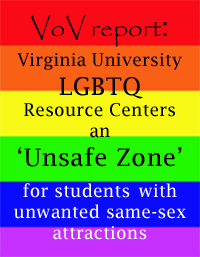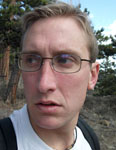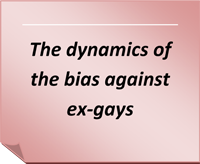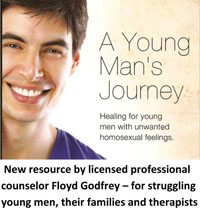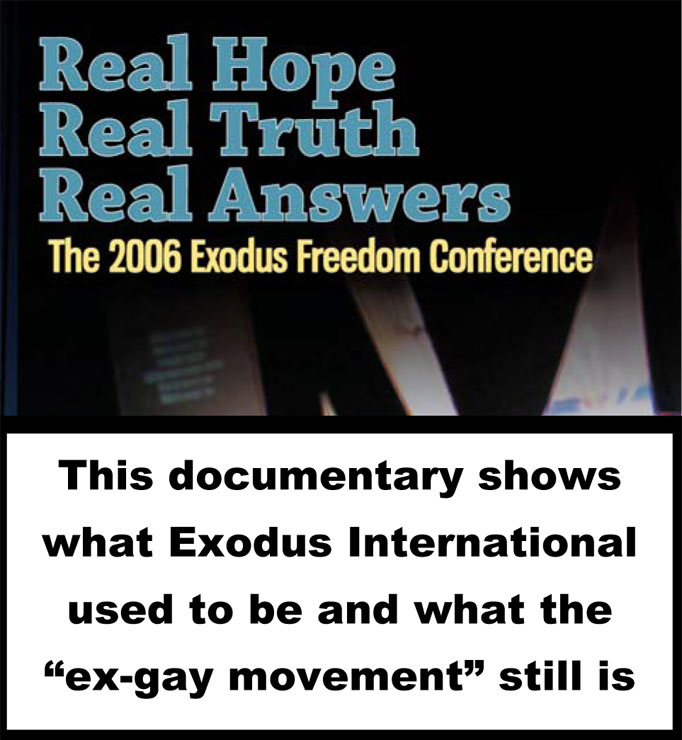The Journey
By Thomas Coy
The Inspiration
The idea of making a documentary on the conflict over homosexuality came in the fall of 2005. I had started researching material for a thesis looking at how homosexuality was treated before it became a political hot potato. I started with the intent of producing a documentary showing both sides of the conflict over homosexuality, and may in the future follow through on that project. One of the events I planned on video taping at was a six day event called The 2006 Exodus Freedom Conference in Marion, Indiana. Because the event was so large and long, the possibility existed that a documentary on the conference alone would be an exceptionally informative and interesting project. Not very many Americans are aware that a Christian ex-gay ministry has existed for over thirty years and I was not aware of another documentary that attempted to accurately illustrate an ex-gay conference.
Video Taping At The Conference
I contacted Exodus International and was put under the authority of their media relations director, Julie Neils. I was allowed to video tape conference speakers and interview leaders and attendees with the verbal agreement that Exodus International would not consent to any of the video tape being used until they reviewed and approved of the final product. Their concern was that Exodus International and the persons in the documentary might be misrepresented and taken out of context. It was a fair concern for an organization that is routinely misrepresented in the media. I had no problem with the agreement, because I was already somewhat familiar with what Exodus was about and it was my intent to portray the conference as accurately as possible. I was also an unknown person to Exodus International and inexperienced in video production. For me it was a great opportunity.
I had tried to get an experienced cameraman to come with me to Indiana, but it did not pan out. My camera experience had begun about seven months earlier and the only training I had was a couple experiences with a local television crew and a book on video production. My biggest technical problem was the spotlights on the speaker’s faces in the main auditorium. To be honest I did not know how to compensate for the spotlight on the faces and I did not know how much the color of the speaker’s shirts and the background affected how the camera adjusted its aperture. I would not understand the dynamics of the problem until my editor Joel Kaplan explained them to me several months later.
My idea for the content of the documentary was to show the conference from several angles. Besides what was going on inside the main auditorium, I wanted to capture the conference through the eyes of attendee’s, through workshop leaders, and through the perspective of Exodus leaders. I made all of the attendees I interviewed aware that there would be an approval process with Exodus International before a final product would be released using their images. In the interviews I sought information from the workshop leaders and personal experiences from the attendees. In all I shot about sixteen hours of video tape.
I was very moved by the conference; the testimonies of ex-gays were inspiring stories of triumph, the messages of the speakers were convicting, and there was an overwhelming compassion for those struggling with unwanted same-sex attractions. All of the attendees I talked with during the six days of the conference had positive things to say about the conference.
The Work After The Conference
I had decided before the 2006 Exodus Freedom Conference that I was going to hire an experienced editor to edit my documentaries, and a conference workshop leader, Christine Sneeringer, told me about Joel Kaplan. Joel was familiar with Exodus ministries through work he had done with local Exodus ministry leaders. When I contacted Joel he said he was the man for the job, and I was thrilled to have an experienced editor enthusiastic about the project. Joel not only agreed to use his expertise with his editing equipment, but to act as a consultant in every aspect of the project he worked on. Joel advised me on the length of the interviews for the documentary transcript, on the importance of b-roll, and some basics on shooting b-roll drama – to tell a story and vary the camera shots.
I edited the dialogue to present a wide variety of information on homosexuality to the viewer; not in depth, but as an introduction. Some of the introductory knowledge on homosexuality that was intentionally put into the documentary includes: the existence of many people who have successfully overcome homosexuality; the fact that sexual orientation change is possible, but difficult; that there is no evidence of a gay gene causing homosexuality, yet homosexuals do not choose to have same-sex attractions; how rejection from the same-sex in childhood and adolescence can be a causative factor of homosexuality; how some parent-child relationships are a causative factor of homosexuality; how child molestation can be a causative factor of homosexuality; the fact that homosexuality can be prevented through right kind of parental nurturing relationships; that many, if not most, people with same-sex attractions are hurting individuals with traumatic rejection in their past; how healthy same-sex friendships are a key ingredient for individuals to overcome homosexuality; the fact that there is a high incidence of drug use and gay on gay violence in the gay subculture; that Christians often do not act Christ-like towards those struggling with homosexuality; moreover, the Christian church has generally failed to help individuals who desire to overcome homosexual behavior; that a gay theology exists claiming that homosexual behavior is not sin; and that many ex-gays have examined gay theology and rejected it as false teaching. Most of the information on homosexuality in this documentary is not common knowledge, because it does not support the politically correct gay perspectives adopted by academia.
There was much more work ahead than I had anticipated once the first transcript of the documentary was put together. Foremost, I needed to come up with a lot of b-roll material. Most of those I contacted were helpful in providing photos. One testimonial speaker I contacted had no photos saved from his childhood, because he did not want to remember his childhood.
I sketched out a series of dramatic scenes to create b-roll for some of the testimonies. It was another time consuming process to contact people, explain the documentary, set up camera shootings, and video tape the many different dramas, but the actual video taping was very enjoyable and creative work. Most of the b-roll actors are from Flint, Michigan and its surrounding communities.
Finally, I had the b-roll needed to set up a time in Joel Kaplan’s editing studio. Joel was able to correct some of my camera problems and his editing intuition for emotion, content, and background music were brillant. I am glad that I was able to work with Joel on this project. He added professionalism to the documentary and on top of that I gained a good friend.
The next step was to send the first draft of the documentary to Exodus International for review and approval. Julie Neils was the person from Exodus to review the documentary and she thought the documentary was very good. Her only suggestions were to make some grammatical corrections in the rolling text of the introduction. Julie provided me with a letter of approval and gave me the go ahead to ask the conference speakers to sign waivers of consent to be in the documentary. Some testimonial speakers were hesitant about signing a waiver and for understandable reasons. For a Christian to admit that they were involved in homosexual behavior is similar to another Christian admitting that they were promiscuous, committed adultery, or had an abortion. Exposing past sin to the general public is not an easy decision. Some will look at the testimonies with sympathy, others with hostility. The gay political movement will probably seek to discredit the speakers and possibly intimidate them. It really is an act of courage and compassion for ex-gays to honestly share their stories.
Concluding Remarks
Christian ex-gays give their testimonies to spread the hope and truth that they have found in Jesus Christ. It is a sacrificial act consistent with the teachings of Jesus. Consider this passage from the Apostle Paul’s last known letter before he was executed by the Romans. In 2 Timothy 1:7 Paul writes, “For God did not give us a spirit of timidity, but a spirit of power, of love and of self-discipline.” From what I have witnessed, the ex-gays that work with Exodus ministries effectively use the spirit of power, love, and self-discipline that comes from God. They are examples that the whole Christian church should look to, because they use this God given spirit to change their own lives and to help others.
From my independent observation and research, I affirm that this documentary is an accurate representation of the 2006 Exodus Freedom Conference and an accurate representation of what Exodus International is about.
Copyright 2008
